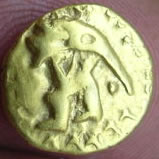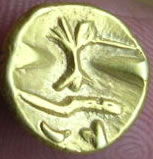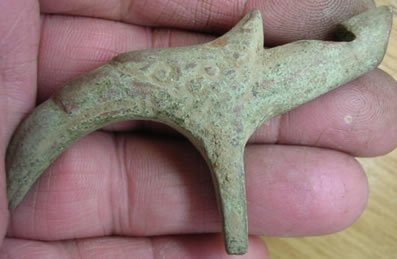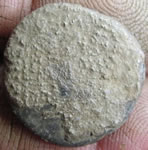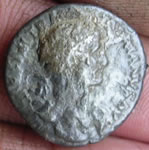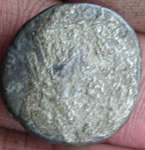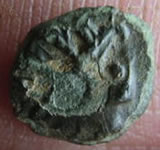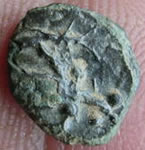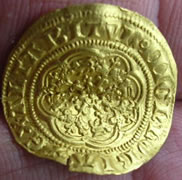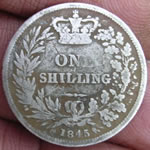

Metal detecting holidays in England with the World's most successful metal detecting club.
Twinned with Midwest Historical Research Society USA
March 2008 finds page |
||||||||||
 |
||||||||||
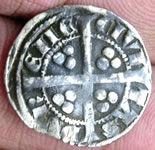  |
 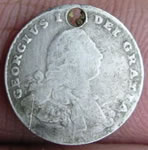 |
|||||||||
1279 Edward 1st hammered silver penny Class 9a mintmark Cross Moline Obv EDWR ANGL DNS HYB Rev CIVITAS DVR/ENE - Durham mint |
1795 George III milled silver penny |
|||||||||
  |
 |
|||||||||
Classic Saxon circle design on a coin weight - Romans used this design as well - needs more research as not in my ref books |
Medieval bronze beehive thimble |
|||||||||
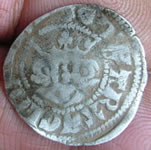 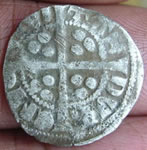 |
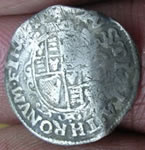 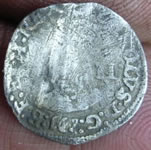 |
|||||||||
1279 Edward 1st hammered silver penny Class 10cf3 mintmark Cross Moline Obv EDWAR ANGL DNS HYB Rev CIVITAS DVR/EME - Durham mint |
1625 Charles 1st hammered silver half groat |
|||||||||
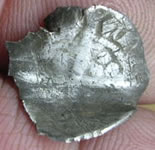 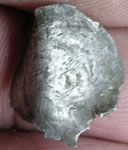 |
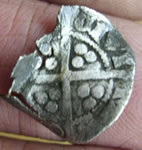 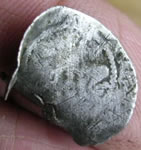 |
|||||||||
Medieval long cross hammered silver penny |
1279 Edward 1st hammered silver penny |
|||||||||
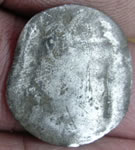  |
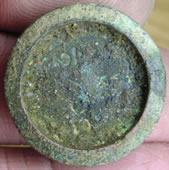 |
|||||||||
16thc Elizabeth 1st hammered silver half groat |
Victorian 2oz trade weight - Crown VR mark |
|||||||||
  |
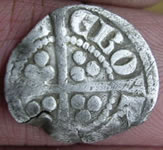  |
|||||||||
Silver snake head - not sure it has much age but will be reported as potential treasure to Colchester FLO |
1351 - 52 Edward III hammered silver penny - Cross 3 Series C Rev CIVITAS EBO/RACI - York mint |
|||||||||
 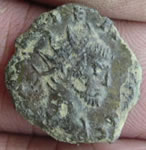 |
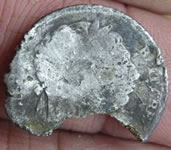 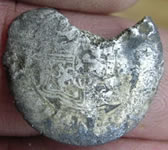 |
|||||||||
3rd C Roman bronze Easy one, this is either an official issue, or a somewhat-better-than-average contemporary copy (of the sort referred to in a rather arch and pejoritive manner by our Victorian forbears in the numismatic field as "Barbarous Radiates") of a Tetricus I AE antoninianus. The reverse type of PAX AVG has Pax standing left holding an olive-branch and transverse scepter. The obverse legend is somewhat unclear, but would probably be IMP C TETRICVS PF AVG or something very similar.
Compare to: http://www.stoa.org/gallery/album110/ML_05_Tetricus_I_Pax_ant1 or http://www.stoa.org/gallery/album110/ML_06_Tetricus_I_Pax_ant2
and also with:
Here you can see how broad the range of style is within these issues and types - some of the ones "on the edge" are just a judgement call as to whether they're to be called copies or official - with some, there is no doubt that they're unofficial.
If official, the mint would likely be Cologne or Vienne (Gaul, not Vienna / Vindabona), 272-3 A.D. and be at least very similar to SR11243. If a contemporary copy, it would date to the same basic time-frame, possibly plus a year or two (up to around 274 and Tetricus' capitulation to Aurelian) but the mint-site, of course, would be unknown.
Mark
|
19thC George III milled silver sixpence |
|||||||||
 |
 |
 |
||||||||
1856-1860 Livery button 'FORTITER IN BE' FIRMIN & SONS 153 Strand & 13 Conduit St |
16thC Tudor clothing fastener |
Medival bronze casket key fragment |
||||||||
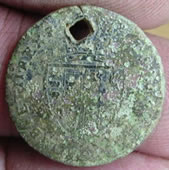  |
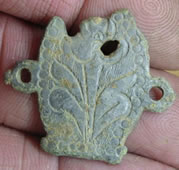 |
|||||||||
18thC George III spade guinea gaming token |
17thC clothing fastener |
|||||||||
 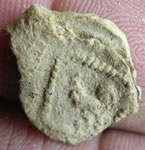 |
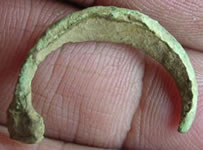 |
|||||||||
Post medieval lead cloth seal |
Roman 'Delos' buckle frame |
|||||||||
 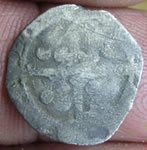 |
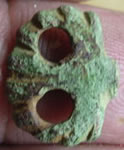 |
|||||||||
1413 AD Henry V hammered silver penny |
Looks like a Medieval spur fragment but needs more research |
|||||||||
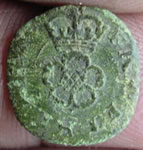  |
 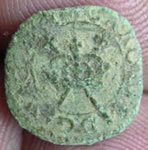 |
|||||||||
1634 -36 Charles 1st Rose hammered copper farthing type 2 Obv CAEOLU D G MAG BRIT Rev FRA ET HIBER REX |
Interesting Rose farthing as Obv legend is unlisted 1634 -36 Charles 1st Rose hammered copper farthing type 2 Obv CAEOLU D G MAG BRIT Rev FRAN ET HIB REX OV ?? |
|||||||||
 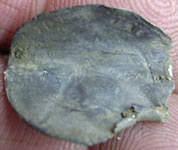 |
||||||||||
16thc Elizabeth 1st hammered silver half groat (9) |
||||||||||
70BC Morini 'boat tree' Celtic gold qtr stater 11.07mm, 1.48g Thanks for this, what a good start to the season! I think it's still stars - it would be nice to think that it's an This'll be CCI 08.9087.
|
||||||||||
 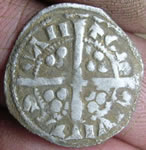 |
 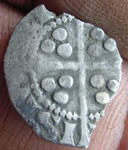 |
|||||||||
1279 Edward 1st hammered silver penny class 9c Obv EDWR ANGL DNS HYB Rev CIVITAS CAN/TOR - Canterbury mint |
1279 Edward 1st hammered silver penny - type 3d inital mark cross potent Rev aBR/ISTO/LLIE - Bristol mint |
|||||||||
 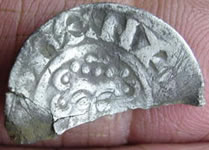 |
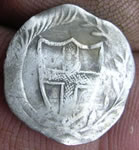 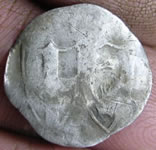 |
|||||||||
1199 King John voided short cross class 5c Moneyer Willelem London |
1649 Commonwealth hammered silver half groat (2 pence) | |||||||||
|
||||||||||
Decorated hawking whistle - not in the ref books, needs more research |
||||||||||
  |
  |
|||||||||
1279 Edward 1st hammered silver penny fragment |
1344 - 51 Edward III hammered silver penny - Florin type Rev EDWAR ANGL DNS HYB Obv CIVITAS LON/DON - London mint |
|||||||||
 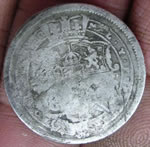 |
 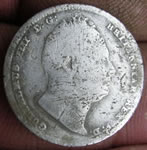 |
|||||||||
1819 George III milled silver shilling |
1835 William IIII milled silver sixpence |
|||||||||
 |
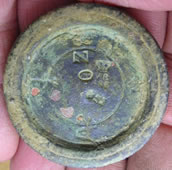 |
|||||||||
Huge lead Georgian carriage crest |
Victorian 2oz trade weight - Cown VR mark |
|||||||||
 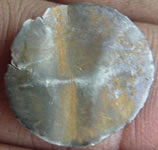 |
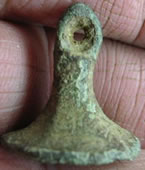 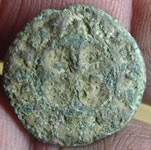 |
|||||||||
14thC hammered silver penny |
Medieval seal matrix |
|||||||||
 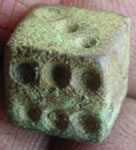 |
 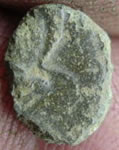 |
|||||||||
Copper alloy dice - needs research to date it |
Roman minimus coin sent for ID well, I'm afraid I can't make any sense out of the dominant design element. This one I was fairly certian was unofficial, and the reverse tends to reinforce this opinion. The reverses were cruder, in general, than the obverses, and not unlike the Celtic coins of an earlier century, the types tended to break down to salient design elements which suggested the reverses of official coins - the looping left arm of Spes hitching her skirt, the outstretched right arm with olive-branch of Pax, etc. what remains here is surely supposed to suggest a common reverse subject, but which one, I just can't say.
Mark
|
|||||||||
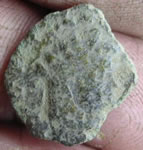 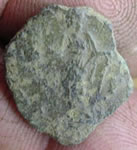 |
  |
|||||||||
3rdC Roman bronze sent for ID reverse appears to be Fortuna (as on your Hadrian denarius), but standing left with her left hand on the handle of a rudder. This is a little unusual, since it's usually her right that rests on the rudder. At any rate, this leaves us right out of saying it's from the Constantinian age - Fortuna was not on the short list of formulaic reverse subjects used in the 4th century - so it must be a 3rd century product. I would guess that it is official, from the quality of the engraving, but I'm still uncertain about who's on the obverse - call it "latter half of the 3rd century, probably an official antoninianus of an uncertain ruler" and that would be about as close as I can get it. |
1247 Henry III hammered silver voided long cross half penny (16) |
|||||||||
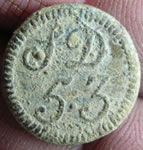 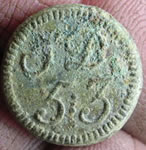 |
 |
|||||||||
1770 George 1/4 gold guinea 5 shillings and 3 pence coin weight |
15thC lead long cross token |
|||||||||
 |
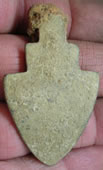 |
 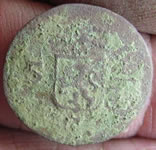 |
||||||||
RN Master - 1807-1825
|
Post medieval shield mount |
1808 Louis Napoleon, King of Holland - Netherlands East Indies 1/16th of a Guilder
|
||||||||
 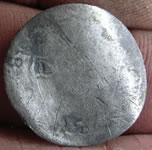 |
  |
|||||||||
1696 William III milled silver sixpence - love token |
17thC circular mount with 2 integral lugs |
|||||||||
 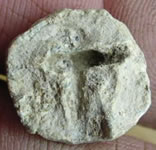 |
 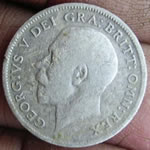 |
|||||||||
Medieval lead gaming piece |
1922 George V milled silver sixpence |
|||||||||
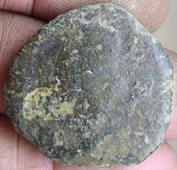 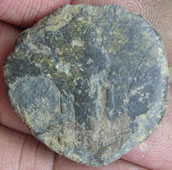 |
 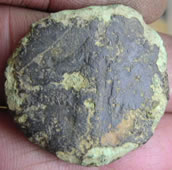 |
|||||||||
1st/2ndC Roman bronze sent for ID Now, I'm guessing at the size and weight based on your fingers in the picture - some metrology might be helpful - this is approximately 27-30mm diameter - or the coin originally was that size before all the edge-chipping occurred. We have a bit of legend at 10:30 obverse, - unfortunately it's a rather less than revelatory 'AVG', but knowing that AVG appears in the obverse legend at or near the mid-point might be very important in the deductive process. Next, we have the standing deity or personification on the reverse, but more importantly, we have the fairly unusual occurrence of a legend written horizontally across the fields. From the portrait, My first guess was Hadrian, but I found no across-the-field reverse legends for him which fit with the relatively few of his obverse legends having AVG in the middle. Antoninus Pius, however, has a sestertius with obverse legend ANTONINVS AVG PIVS P P TR P and PAX - AVG (a plausible reading of your coin's field-legend) across the reverse field - COS III S - C - Pax standing left, setting fire to a heap of arms and holding a cornucopia. Unfortunate there is so little design left to show the heap of arms, this is a rather ambitious coin-reverse. Your coin seems a bit skimpy for a sestertius, and without measurements, was initially tempted to say it's an As - however, no As with this type is known for Antoninus. Of course, I suppose that a coin that started out on the smaller side and then was mumbled about in the field by plows, etc, resulting in several visible generations of edge chipping could easily be reduced to this size. So, my best guess is Antoninus Pius, Mint of Rome, 147 A.D. Brass sestertius. PAX AVG COS IIII SC - RIC III 777, SR 4201.
|
1st/2ndC Roman bronze 147 AD Now, I'm guessing at the size and weight based on your fingers in the picture - some metrology might be helpful - this is approximately 27-30mm diameter - or the coin originally was that size before all the edge-chipping occurred. We have a bit of legend at 10:30 obverse, - unfortunately it's a rather less than revelatory 'AVG', but knowing that AVG appears in the obverse legend at or near the mid-point might be very important in the deductive process. Next, we have the standing deity or personification on the reverse, but more importantly, we have the fairly unusual occurrence of a legend written horizontally across the fields.
From the portrait, My first guess was Hadrian, but I found no across-the-field reverse legends for him which fit with the relatively few of his obverse legends having AVG in the middle.
Antoninus Pius, however, has a sestertius with obverse legend ANTONINVS AVG PIVS P P TR P and PAX - AVG (a plausible reading of your coin's field-legend) across the reverse field - COS III S - C - Pax standing left, setting fire to a heap of arms and holding a cornucopia. Unfortunate there is so little design left to show the heap of arms, this is a rather ambitious coin-reverse. Your coin seems a bit skimpy for a sestertius, and without measurements, was initially tempted to say it's an As - however, no As with this type is known for Antoninus. Of course, I suppose that a coin that started out on the smaller side and then was mumbled about in the field by plows, etc, resulting in several visible generations of edge chipping could easily be reduced to this size.
So, my best guess is Antoninus Pius, Mint of Rome, 147 A.D. Brass sestertius. PAX AVG COS IIII SC - RIC III 777, SR 4201.
|
|||||||||
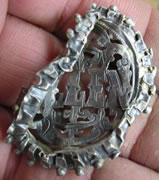 |
  |
|||||||||
Solid silver name brooch, hall marked 1905 'Ellen' |
17thC button |
|||||||||
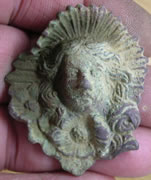 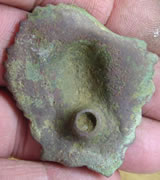 |
 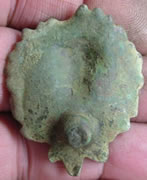 |
|||||||||
Georgian mount |
Georgian mount |
|||||||||
 |
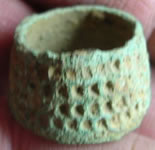 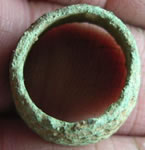 |
|||||||||
Unusual 15th lead token - possible coin weight |
15thC open top bronze thimble |
|||||||||
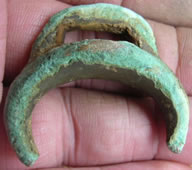  |
||||||||||
| Fragment of a Romano-Britsh protected loop terret.22.99g, 38.53mm W x 34.56mm H x 15.78 mm T |
||||||||||
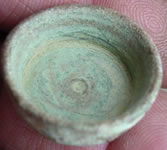 |
||||||||||
Hollow silver pin 0.98g, 35.61 L x 8.05 mm W Reported as potential treasure |
Georgian cup bullion weight |
|||||||||
 |
 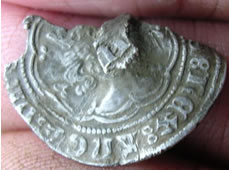 |
|||||||||
18thC decorated clog fastener |
1361 - 1369 Edward III hammered silver half groat - treaty period
Obv EDWARD REX ANGLIE DNS HIB Rev CIVITAS LON/DON - Lodon mint |
|||||||||
  |
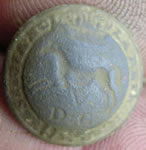 |
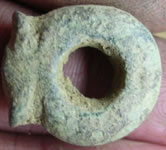 |
||||||||
Medieval Madonna mount |
Unlisted 5th Dragoon guards button - Crimea wars period |
3rd C Roman 'Newstead' type lorica tie loop |
||||||||
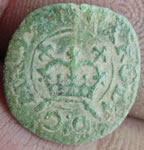  |
 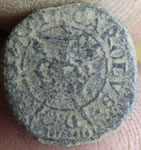 |
|||||||||
1634 -36 Charles 1st Rose hammered copper farthing type 2 Obv CAEOLU D G MAG BRIT Rev FRA ET HIBER REX |
1634 -36 Charles 1st Rose hammered copper farthing type 2 Obv CAEOLU D G MAG BRIT Rev FRA ET HIBER REX |
|||||||||
Stunning Roman silver coin , 'cooked', cooked some more and still 'cooking' to remove 'horn' crust |
||||||||||
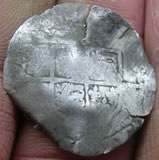 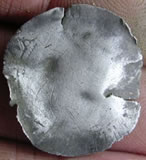 |
 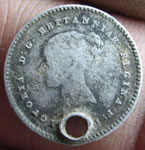 |
|||||||||
1554 Mary hammered silver groat (18) |
Tiny 1838 Victorian milled silver 2 pence |
|||||||||
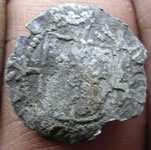 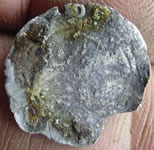 |
 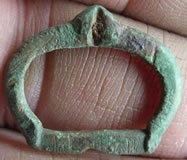 |
|||||||||
16thC Elizabeth 1st hammered silver half groat |
Really nice decorated Medival D buckle |
|||||||||
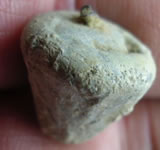 |
 |
 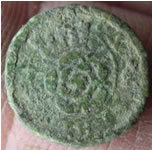 |
||||||||
Post medieval lead plumb bob |
18thC nipple button |
1634 -36 Charles 1st Rose hammered copper farthing type 2 Obv CAEOLU D G MAG BRIT Rev FRA ET HIBER REX Curious piece as someone has hammered the edge flat |
||||||||
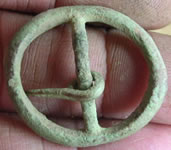 |
 |
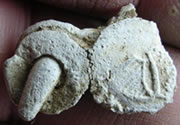  |
||||||||
Medieval annular buckle |
19thC livery button |
17thC Commonwealth lead cloth seal |
||||||||
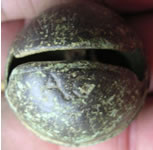 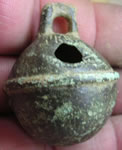 |
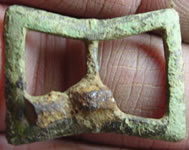 |
|||||||||
17th C Allen Gurney - AG crotal bell – Hull foundry |
1550 -1650 buckle |
|||||||||
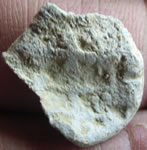 |
 |
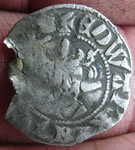 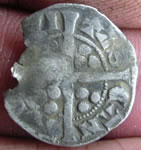 |
||||||||
15thC lead token |
|
1344 1351 Edward III hammered silver penny Florin type Class 15d Obv EDWAR R ANGL Rev CIIVTAS CAN/TOR - Canterbury mint |
||||||||
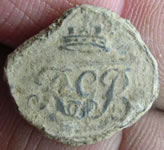 |
 |
 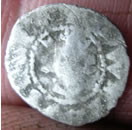 |
||||||||
Crown RGB button |
Roman armour buckle |
1279 Edward 1st hammered silver sterling farthing type 28 0.27g, 11.51mm Obv EDWARDVS REX Rev CIVITAS LONDON - London mint |
||||||||
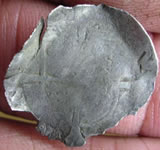 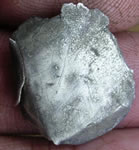 |
 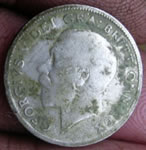 |
|||||||||
1554 Mary hammered silver groat (23) |
1923 George V milled silver sixpence |
|||||||||
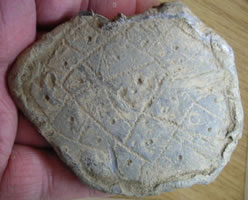 |
 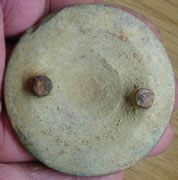 |
|||||||||
It appears to be a lead map - could be Medieval |
Huge circular mount or shield boss |
|||||||||
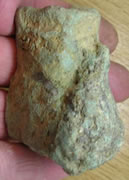 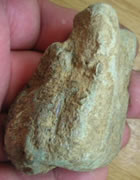 |
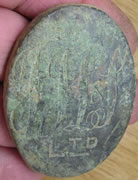 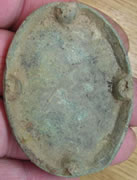 |
|||||||||
Huge Roman bronze pot foot |
Victorian Harness name plate mount TJLS Ltd |
|||||||||
 |
||||||||||
17thC hanging pendant |
||||||||||
 |
 |
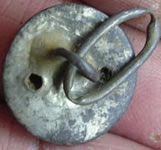  |
||||||||
15thC lead long cross token |
Georgian button |
Georgian silver button |
||||||||
 |
 |
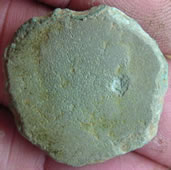 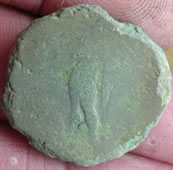 |
||||||||
Georgian watch winder |
16thC Tudor button |
1st/2nd C Roman bronze coin |
||||||||
1718 George 1st gold half guinea - 4.14g, 21.35mm |
Celtic bronze stater - possible Morini tribe sent to CCI for recording 0.42g, 9.11mm |
|||||||||
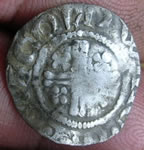 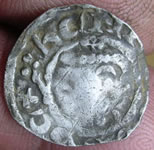 |
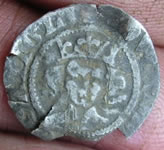 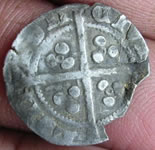 |
|||||||||
1190 AD Richard 1st hammered silver penny Class 3 Moneyer GOLDWINE LONDON |
1356 - 1361 AD Edward III Pre Treaty series G - Initial mark Cross 3 - annulet at centre of the group of 3 pellets in each qtr - annulet stops Obv EDWARDVS REX REX ANGLI (F) Rev CIVITAS LON/DON - London mint (25) |
|||||||||
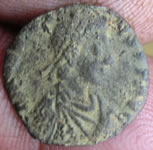 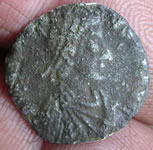  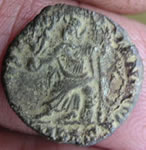 |
||||||||||
'Yes, it appears to be a Siliqua - VIRTVS ROMANORVM type - I'm not certain, but I think it's Gratian (370's AD) and probably from Trier'. Wow -the reason you haven't seen any 4th century silver is that, quite simply, there is so little remaining. The Romans were too broke by that time to be able to afford to use silver for money in the homeland. All those copper coins you find are the equivalent of Pound notes or "Fivers" - a fiduciary currency whose stated value in trade is far above any intrinsic value it might have. There was an attempt to restore dependable, circulating precious-metal coins which was fairly successful in the case of the gold solidus which replaced a scramble of differently sized and variously fine "Aureii" from the chaotic end of the 3rd century - and unsuccessful in the case of the Argenteus/Siliqua - the silver was sucked out of the Empire by overseas purchases and military spending, so the argenteus was quickly debased until it was also indistinguishable from AE. The Siliqua became so popular, however, for buying-off the "barbarians" (who wouldn't take copper fiduciary currency as a bribe!) that it eventually stuck and by the middle of the 4th century, siliquae were actually circulating again at a fineness not seen since the time of Nero. (~.900 fine) But it's the eternal fate of good-quality circulating precious metal coins to be the first into the pot when it's time for a re-coining for a different name, country or denomination, so the siliquae of the later 4th century are still pretty scarce. A couple rulers, Constantius II, Valens, Valentinian, Julin II pumped-out so much silver in siliquae that theirs aren't quite so rare, but as I was told many years ago (and it's a bit of an underestimation rather than an exaggeration) "You'll handle 100 denarii for every siliqua you ever see." It's the truth.
Mark |
||||||||||
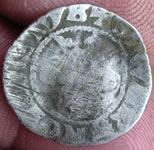 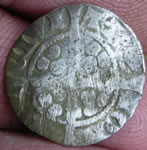 |
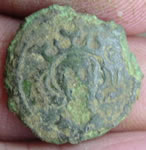 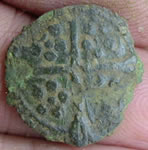 |
|||||||||
1279 Edward 1st hammered silver penny - class 10cf3 obv ERWAR ANGL DNS HYB Rev CIVI/TAS LOND/DON - London mint |
1321 -43 Edward II hammered bronze jetton Class XV Obv Bust Class 15 in circle :border pellets Rev Long cross patonce, 4 pellet clusters in angle: border stars Ref Mitchiner 135 |
|||||||||
 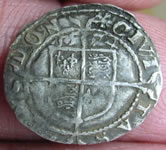 |
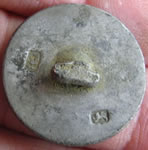 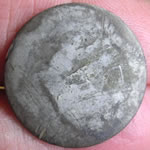 |
|||||||||
| 1574 Elizabeth 1st hammmered silver half groat - double struck head | 18thC solid silver button with Lion hallmark and markers initials |
|||||||||
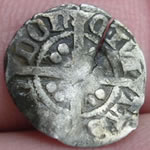 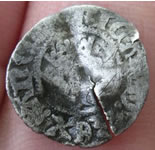 |
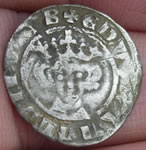 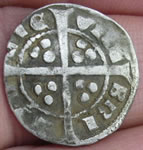 |
|||||||||
1377 -1399 Richard II hammered silver halfpenny - Type 1j obv RICHARD:REX:ANGL Rev CIVITAS LON/DON - London mint 0.46g, 13.90mm |
1279 Edward 1st hammered silver penny 9b obv EDWR R ANGL DNS HYB Rev VILLA/BRI/STO/LIE - Bristol mint |
|||||||||
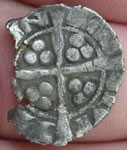  |
  |
|||||||||
1279 Edward 1st hammered silver penny Obv EDWAR ANGL *** Rev CIVITAS LON/DON - London mint |
1216 Henry III hammered silver shortcross penny fragment (31) |
|||||||||
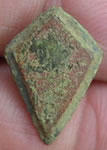  |
  |
|||||||||
17thC mount with 2 integral lugs |
17thC mount with 2 integral lugs |
|||||||||
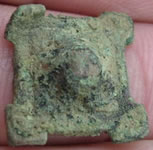 |
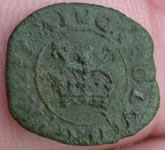 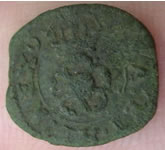 |
|||||||||
Medieval mount - single integral lug missing |
1634 -36 Charles 1st Rose hammered copper farthing type 2 Obv CAEOLU D G MAG BRIT Rev FRA ET HIBER REX |
|||||||||
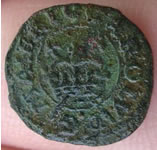  |
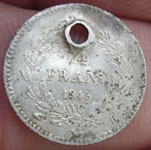 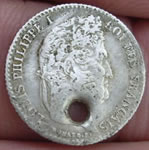 |
|||||||||
1634 -36 Charles 1st Rose hammered copper farthing type 2 Obv CAEOLU D G MAG BRIT Rev FRA ET HIBER REX |
1845 French Louis Philipp milled silver 1/4 Franc |
|||||||||
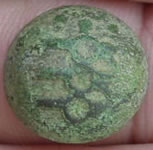 |
 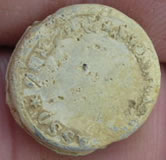 |
|||||||||
1790 Royal artillery 3 cannons button |
Neat Lead bale seal with 19thC paddle steamer ship design |
|||||||||
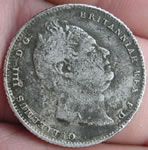 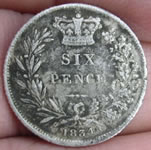 |
  |
|||||||||
1834 William IIII milled silver sixpence |
King John 1199 - 1216 hammered silver short cross half penny - Moneyer Iohan - Canterbury mint Class 5b |
|||||||||
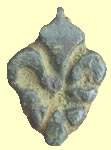 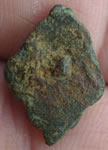 |
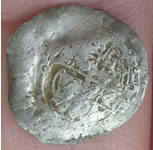 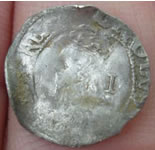 |
|||||||||
Medieval bronze Fluer di Lis mount with single integral lug |
1625 Charles 1st hammered silver penny |
|||||||||
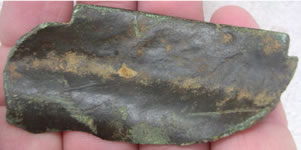 |
  |
|||||||||
Roman bronze pot fragment |
1247 Henry III voided long cross hammered silver half penny Moneyer Nicole obv NIC(/OLE(/ONC(/ANT (34) |
|||||||||
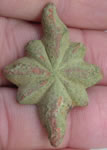 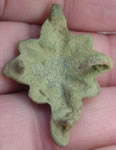 |
 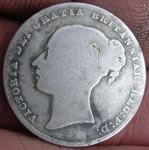 |
|||||||||
17thC mount with 3 integral lugs |
1859 Victorian milled silver shilling ( 12 pence) |
|||||||||
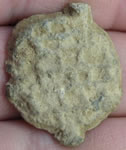 |
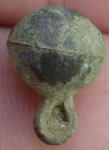 |
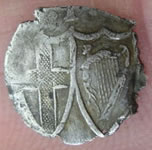 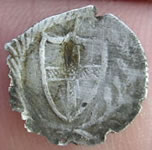 |
||||||||
| 15thC lead token with casting spuces | 17thC tunic toggle button |
1649 Commonwealth hammered silver one pence |
||||||||
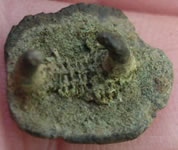  |
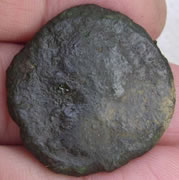 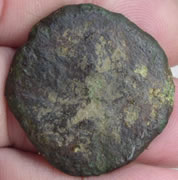 |
|||||||||
16thC mount with 2 integral lugs |
1st/2nd C Roman bronze sent for ID ,20.45g, 32.29mm This one can only be a sestertius - the big brass quarter-piece of the silver denarius - and most likely from the 2nd century AD. There isn't much more I can tell you, however, with no readable legends (readable by me, at least - are there any fairly clear letters around 1:00-2:00 on the obverse? It looks like there might be something there, but I can't be sure from your picture, even when I enhance the contrast.)
Working strictly from the silhouette, which appears to show a bun on the back of the head, it would seem likely to be one of the later Antonine wives - who mostly were portrayed with that sort of hairstyle - Faustina II, wife of Marcus Aurelius, Lucilla, wife of Lucius Verus, or Crispina, wife of Commodus - if it's one of these three, it dates to the 2nd half of the 2nd century. If, however, that's not a bun, just a raised area of corrosion, and if I had to guess at a male silhouette, I'd say either Trajan or Antoninus Pius, putting it in the 1st half of the 2nd century.
I'm afraid there's not enough detail on the reverse for me to hazard a guess at the reverse type - the 2nd century was famous for the huge variety of its reverse types - even if I were sure of the ruler, there could be dozens - in some cases, hundreds - of possible reverses.
Mark
|
|||||||||
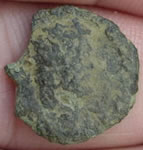 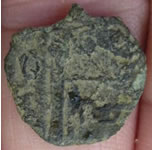 |
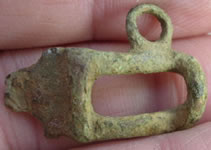 |
|||||||||
3rdC Roman bronze sent for ID, 1.28g, 15.95mm It appears to be a posthumous commemorative antoninianus of Claudius II Gothicus. He inherited the chaos at Gallienus' death. A soldier-general under Gallienus, he did fairly well during his rule, considering what he had inherited, winning several crucial battles, but plague had been brought into Europe by the Goths whom he defeated at Naissus - he was among the Romans who contracted and subsequently died of the plague - after only 2 years of rule - in 270 AD.
The "CONSECRATIO" series of posthumous commemoratives in the name of "DIVO CLAVDIO" - the deified Claudius - was huge, and was also the prototype for an equally enormous, or possibly greater number of unofficial issues copying them. Workmanship had slipped so badly, and the size of coins had been reduced so much at the mint in Rome that it is not at all easy to be certain in many cases whether a piece is official or imitative.
This appears to be either an official issue, or a better-than-averge imitative of the CONSECRATIO series showing an altar on the reverse. All we have to go on, however, is the fairly distinctive, bearded portrait and the straight lines on the reverse there isn't enough clear legend to read at all. Very few reverse subjects in this era were not curvilinear - so with straight lines, an altar is all I can think this was supposed to be. -
See: http://www.stoa.org/gallery/album106/ML_13_Claud_II_Consecratio_Altar1 for a presumed official issue and: http://www.stoa.org/gallery/album106/ML_19_Claud_II_Consecratio_Altar6 for a presumed contemporary copy, and: http://www.stoa.org/gallery/album106/ML_15_Claud_II_Consecratio_Altar3 for a fairly certain contemporary copy - you can see how little diffference some of the imitatives show from the official issues the copy.
Mark
|
17thC sword belt fitting |
|||||||||
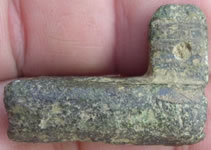 |
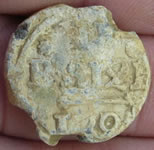 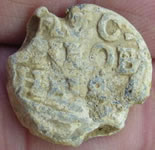 |
|||||||||
Medieval barrel lock bar fragment |
1791 Russian lead bale seal |
|||||||||
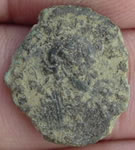 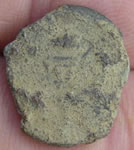 |
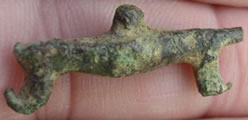 |
|||||||||
3rdC Roman bronze sent for ID
2.06g, 18.90mm This piece also appears to be a DIVO CLAVDIO / CONSECRATIO posthumous antoninianus of Claudius II, c. 270 AD, and also seems to be of the altar reverse type, although you can see that the style of the altar is vastly different on this than on the last one. These commemoratives were struck by his short-lived successor, his younger brother Quintillus - but he was so short-lived (some sources say only a few weeks) that it seems unlikely that the huge posthumous commemorative series for Claudius II was accomplished during his reign, so it assumed these types (there are also common eagle reverses and some showing a funeral pyre) continued to be struck in the early months of Aurelian's reign.
|
Roman |
|||||||||
 |
 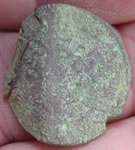 |
|||||||||
Post medieval spur fragment |
1586 Hans Krauwincel II Rose orb Jeton HANNS KRAVWINCKEL IN NVRENB |
|||||||||
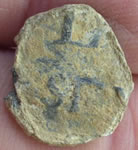 |
 |
  |
||||||||
Early pewter button - possibly miltary |
Post medieval Huge bronze pot foot |
1923 george V milled silver sixpence |
||||||||
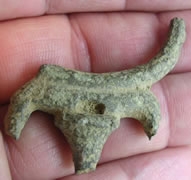 |
  |
|||||||||
Medieval reins guide fragment |
17thC Charles II fob seal - 'Carolius' |
|||||||||
  |
 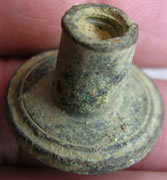 |
|||||||||
1816 Geroge III milled silver sixpence |
Large Georgian desk seal matrix |
|||||||||
  |
  |
|||||||||
1641-3 Charles 1st hammered silver penny - mintmark 2 dots 'triangle and circle' King had left London and Parliament stuck these coins |
1361 Edward III transitional treaty period hammered silver penny Large pellet stops and crozier before CIVI obV EDWARD ANGLE DN HIB Rev CIVI/TAS DOR/ELME - Durham mint |
|||||||||
  |
  |
|||||||||
1834 Russian bale seal |
17thC decorated mount with 2 integral lugs, missing |
|||||||||
 |
  |
|||||||||
Medieval lead pyramid gaming pice |
17thC copper alloy mount with 2 integral lugs |
|||||||||
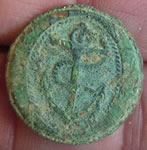 |
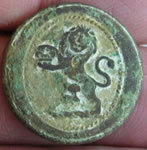 |
 |
||||||||
RN Capt / Commander - 1787 RN Lieutenant - 1787 |
18thC Trinty House Pilot ? |
1550 -1650 buckle |
||||||||
  |
  |
|||||||||
1st/2nd C Monster sized Roman bronze sent for ID - 11.02g, 32.44mm |
1st/2nd C Roman bronze sent for ID - 12.97g, 27.94mm |
|||||||||
 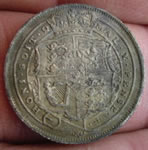 |
 |
|||||||||
Really crisp 1820 George III milled silver sixpence |
Post medieval - Intersting D buckle shaped ring and swivel |
|||||||||
  |
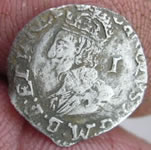 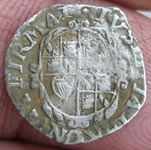 |
|||||||||
Stunning 1582-3 Elizabeth 1st hammered silver half groat (2 pence) - Sixth issue bell mintmark - the detail on this strike is amazing |
Stunning strike 1641-3 Charles 1st hammered silver penny - mintmark dot 'triangle and circle' King had left London and Parliament stuck these coins |
|||||||||
  |
  |
|||||||||
South Wales copper Conder farthing token dated 1793. Obverse: Bust to right: "SOUTH WALES FARTHING". Reverse: Prince of Wales crest within shield above sprigs of flowers: "PRO BONO PUBLICO 1793". Plain edge |
1344 -1351 Edward III Third 'Florin'coinage Type 3 hammered silver penny obv EDWAR ANGL DNS HYB Rev CIVI/TAS/LOND/DON London mint 1.30g, 18.43mm |
|||||||||
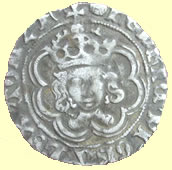  |
 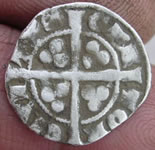 |
|||||||||
Henry VII 1486- 1504 Obv HENRIC DI GRA REX A** Z FR- Tun Mintmark - Class II Rev CIVI/TAS/CAN/TOR - Canterbury mint 1.37g, 18.94 |
1344 -1351 Edward III Third 'Florin'coinage Type 3 hammered silver penny Obv EDWAR ANGL DNS HYB Rev CIVI/TAS/CAN/TOR - Canterbury mint 1.34g, 17.74mm |
|||||||||
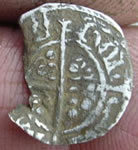  |
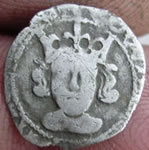  |
|||||||||
1377 -1399 Richard II hammered silver halfpenny Type 5 Small face, wide crown Obv +RICARDxREX:ANGL Rev CIVI/TAS/LONDON - London mint 0.46g, 13.67mm |
1344 -1343 Edward III Third 'Florin'coinage Type 3 hammered silver penny Obv EDWA **** DNS HYB Rev CIVI/TAS/CAN/TOR - Canterbury mint 0.63g, 13.83mm (44) |
|||||||||
Fourth coinage 1356-61 Edward III hammered gold 1/4 Noble Type C Annulet stops 1.96g, 20.36mm Obv shield quartered with the arms of England and France within a treassure of eight arches - EDWARD GRA REX :ANG. . HY Cross 3(4 ) Rev EXALTABITAR IN GLORIA
Annulet stop |
||||||||||
|
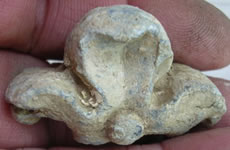 |
|||||||||
1845 Victorian milled silver shilling ( 12 pence) |
Medieval lead mount |
|||||||||
 |
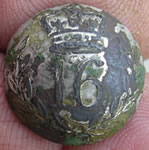 |
 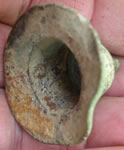 |
||||||||
Georgian watch winder |
|
17thC horse bell |
||||||||
 |
 |
  |
||||||||
c1550-1650 Cast copper alloy buckle |
Georgian mount |
1st/2ndC Roman bronze coin |
||||||||
 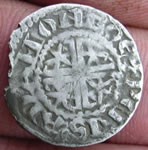 |
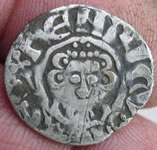  |
|||||||||
Great find - an Alexander II 1214-49 Scottish hammerd penny - rear legend does not match those in reference books- should be PIERIS ON RO - Pierres of Roxburgh - Adam was also out of Roxburgh so the legend looks like the two combined Obv ALEXANDER REX Rev + PERIS ADAM ON ROE 1.24g,17.82mm |
1208/9 King John hammered silver shortcross penny - Class 6b2 Obv HENRICVS REX Rev RAVF ON LVNDE - Randvlf the moneyer - London mint 1.31g,18.16mm |
|||||||||
  |
||||||||||
Medieval Heraldic ring - 2 chevrons |
||||||||||
 |
 |
|||||||||
Cast hammer head - Victorian |
Medieval Bronze pot leg |
|||||||||
  |
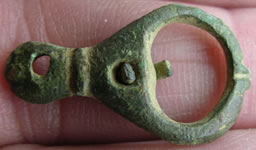 |
|||||||||
1344 -1343 Edward III Third 'Florin'coinage Type 3 hammered silver penny Obv EDWAR ANGL DNS HYB Rev CIVI/TAS/LON/DON - London mint |
Medieval buckle |
|||||||||
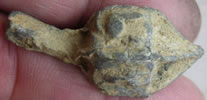 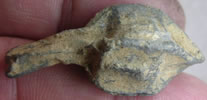 |
||||||||||
A dreidel (Yiddish: דרײדל dreydl, Hebrew: סביבון Sevivon) is a four-sided top, played with during the Jewish holiday of Hanukkah. The dreidel is used for a gambling game similar to Teetotum. Each side of the dreidel bears a letter of the Hebrew alphabet: נ (Nun), ג (Gimel), ה (Hei), ש (Shin), which together form the acronym for "נס גדול היה שם" (Nes Gadol Haya Sham – "a great miracle happened there"). These letters also form a mnemonic for the rules of a gambling game played with a dreidel: Nun stands for the Yiddish word nit ("nothing"), Hei stands for halb ("half"), Gimel for gants ("all"), and Shin for shteln ("put"). In the state of Israel, the fourth side of most dreidels is inscribed with the letter פ (Pei), rendering the acronym, נס גדול היה פה, Nes Gadol Haya Po—"A great miracle happened here" referring to the fact that the miracle occurred in the land of Israel |
||||||||||
 |
 |
|||||||||
Military badge - probably Staffs |
161 Athletes Volunteer force badge September 20, 1914, Sunday LONDON, Sept 19. -- The English soccer players have got together and formed an organization called "The Athletes' Volunteer Force" for home service, which enables them to keep their engagements with their various clubs during the football season. Many well-known players are already at the front, and they have been followed this week by Lintott of Leeds City, Crab-tree of the Blackburn Rovers, Evans of Aston Villa, and Kelsall of Sunderland |
|||||||||
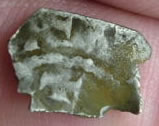 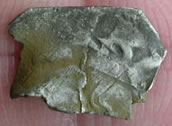 |
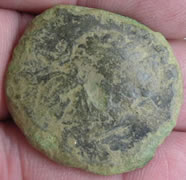  |
|||||||||
Henry III Tealby issue Medieval hammered silver fragment (208) |
1st/2ndC Roman bronze |
|||||||||
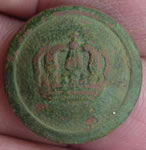 |
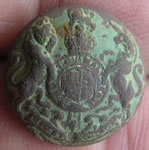 |
 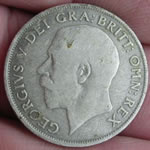 |
||||||||
1880 Prussian Army |
1890 General Service button |
1921 George V milled silver shilling |
||||||||
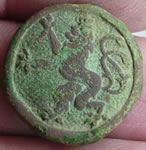 |
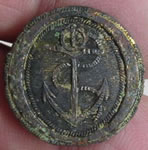 |
 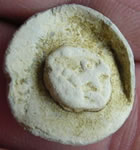 |
||||||||
1880 Prussian Army |
RN Capt / Commander - 1787 RN Lieutenant - 1787 |
Medieval lead cloth seal |
||||||||
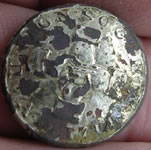 |
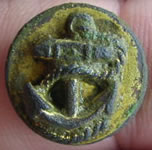 |
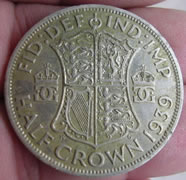 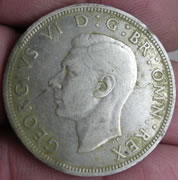 |
||||||||
1714 dated button Union Society |
Generic Merchant Navy Officers |
1939 George V milled silver half crown (30 pence) |
||||||||
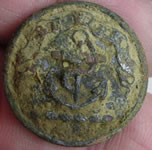 |
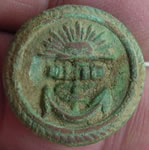 |
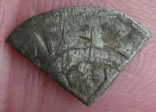 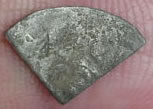 |
||||||||
'BE FIRM' 1895 Pitt & Co Maddox St London |
P&O Line
In use 1920 - 1940s Maker - Unknown |
1180- 1247 AD hammered silver voided short cross - cut 1/4 penny |
||||||||
  |
 |
|||||||||
1344 -1351 Edward III hammered silver penny Type 1 - cross 3 Obv EDWR A**** DNS HYB Rev CIVI/TAS/LOND/DON - London mint (210) |
Military cap badge |
|||||||||
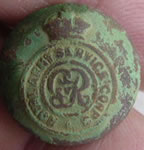 |
 |
  |
||||||||
Royal Army Service Corp |
Victorian decorated mount |
1st/2nd C Roman bronze - figure standing SC | ||||||||
 |
 |
  |
||||||||
1855 on Scotts Guards |
Post medieval pot leg |
1413- 22 Henry V hammered silver half penny - Pierced cross initial mark - 0.925 FINE - Type 3, Small whole annulet either side of crown +HENRIC :REX :ANGL Rev CIVI/TAS/LON/DON - lONDON MINT 0.46g, 12.67mm |
||||||||
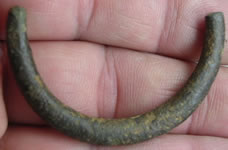 |
  |
|||||||||
Bronze age harness ring |
1696 William III milled silver shilling - love token |
|||||||||
  |
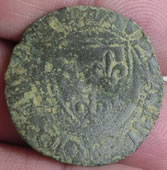 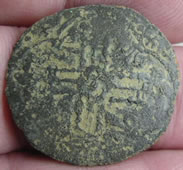 |
|||||||||
1817 George III milled silver sixpence |
French copper- alloy Jetton 1380AD Obv Shield of France bearing three feur de lys
|
|||||||||
 |
 |
 |
||||||||
Medieval hanging pendant |
Roman helmet trim |
Medieval bronze pot leg |
||||||||
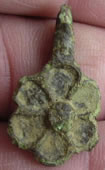 |
 |
  |
||||||||
16thC hanging pendant |
Medieval hanging pendant |
17thC silver milled silver sixpence - love token WT H |
||||||||
 |
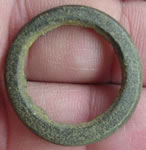 |
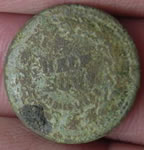 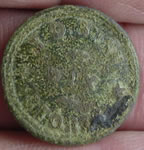 |
||||||||
Medieval buckle tongue |
Medieval harness ring |
T D NUNN Stores WIX Treade token Victorian Half Sovereign ( 10 shillings) |
||||||||
  |
 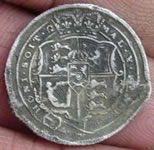 |
|||||||||
1279 Edward 1st hammered silver penny - Bristol mint |
1817 George III milled silver sixpence |
|||||||||
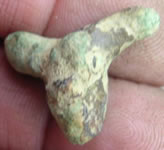 |
  |
|||||||||
Roman prick spur fragment |
1485 - 1509 Henry VII hammered silver penny - uncertain initial mark - star on brest Rev CIVI/TAS/EBO/RACI - York mint |
|||||||||
 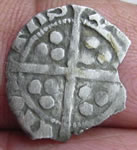 |
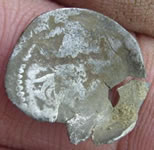 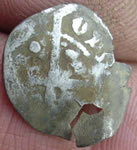 |
|||||||||
1454- 1460 Interesting Henry VI hammered silver penny - Satire and B by the neck - should be a Durham issue with ring in centre of reverse but they are missing ?? Needs more research |
Medieval hammered silver penny - Durham mint |
|||||||||
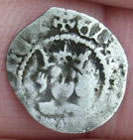 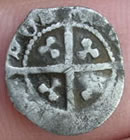 |
  |
|||||||||
Edward 1st to VII - cinneeds more research Ov +EDWARDVS REX Rev does not match any known mints 0.36g, 12.93mm |
1180 - 1199 Henry II hammered silver short cross half penny Moneyer Henry - London
|
|||||||||
 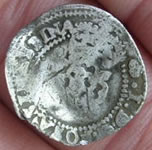 |
 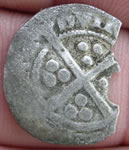 |
|||||||||
1615 -16 James 1st hammered silver half groat - 2nd issue Tun mintmark - 0.69g, 16.17mm |
1377 -1399 Richard II hammerd silver penny Class 1 III Obv ***S REX: **** (RICHARD VS REX: ANGLIE) Rev CIVI/TAS/DVN/*** Durham nint |
|||||||||
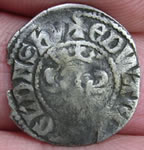  |
 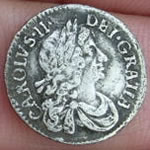 |
|||||||||
1335- 1351 Edward III hammered silver penny Florin issue Obv EDWAR R ANGL' DNS HYB Rev CIVI/TAS/CAN/TOR - Canterbury mint (220) 1.23g, 18.38 |
1679 Charles II milled silver 2 pence |
|||||||||
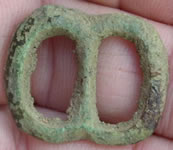 |
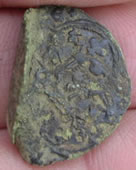 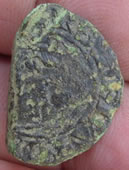 |
|||||||||
1550 -1650 buckle |
Possible purse bar fragment |
French copper- alloy Jetton 1380AD Obv Shield of France bearing three feur de lys |
||||||||
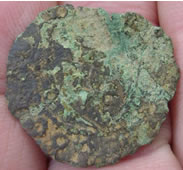 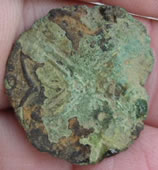 |
  |
|||||||||
French copper- alloy Jetton 1380AD Obv Shield of France bearing three feur de lys |
Medieval gilded mount - chevon design |
|||||||||
 |
 |
  |
||||||||
Roman buckle tongue |
17thC decorated clothing fastener |
Roman bronze decorated mount - single integral lug |
||||||||
 |
 |
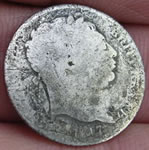  |
||||||||
Post medieval mount |
15thC lead long cross token - long cross and pellet type |
1817 George III milled silver 6 pence |
||||||||
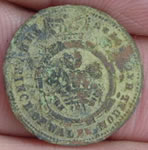  |
|
|||||||||
Victorian - The Prince of Wales model half sovereign |
17thC mount with 2 integral lugs |
|||||||||
  |
||||||||||
| 1180 -1189 Henry II hammered silver 1/4 penny - Class 1b-1c Rev HENRICVS REX Rev *AVI ON - Moneyer Davi London |
||||||||||
 |
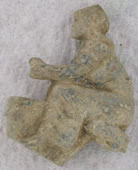 |
  |
||||||||
15thC lead long cross token |
19thC Lady milking lead figure | 1308-27 Edward II hammered silver penny Durham Episcopal coin Bishop Beaumont - Mintmark Lion and Lis |
||||||||
 |
 |
  |
||||||||
Ornate Georgian watch winder |
Medieval lead hanging weight | |||||||||
 |
||||||||||
This seasons find pages |
||||||||||
